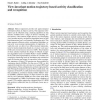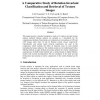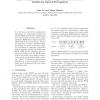388 search results - page 48 / 78 » Using hidden Markov models and wavelets for face recognition |
MMS
2006
13 years 7 months ago
2006
Motion trajectories provide rich spatio-temporal information about an object's activity. The trajectory information can be obtained using a tracking algorithm on data streams ...
BMVC
1998
13 years 9 months ago
1998
This paper presents a detailed comparative study of 4 rotation invariant texture analysis methods. Human subjects are included as a benchmark for the computational methods. Experi...
PRL
2007
13 years 7 months ago
2007
The bottleneck in interactive visual classification is the exchange of information between human and machine. We introduce the concept of the visible model, which is an ion of an ...
MLMI
2007
Springer
14 years 1 months ago
2007
Springer
Eye gaze and gesture form key conversational grounding cues that are used extensively in face-to-face interaction among people. To accurately recognize visual feedback during inter...
NAACL
2003
13 years 9 months ago
2003
It is well known that frame independence assumption is a fundamental limitation of current HMM based speech recognition systems. By treating each speech frame independently, HMMs ...



